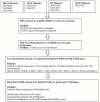Bioinformatics Based Drug Repurposing Approach for Breast and Gynecological Cancers: RECQL4/FAM13C Genes Address Common Hub Genes and Drugs
- PMID: 39744927
- PMCID: PMC11706122
- DOI: 10.4274/ejbh.galenos.2024.2024-11-2
Bioinformatics Based Drug Repurposing Approach for Breast and Gynecological Cancers: RECQL4/FAM13C Genes Address Common Hub Genes and Drugs
Abstract
Objective: The prevalence of breast cancer and gynaecological cancers is high, and these cancer types can occur consecutively as secondary cancers. The aim of our study is to determine the genes commonly expressed in these cancers and to identify the common hub genes and drug components.
Materials and methods: Gene intensity values of breast cancer, gynaecological cancers such as cervical, ovarian and endometrial cancers were used from the Gene Expression Omnibus database Affymetrix Human Genome U133 Plus 2.0 Array project. Using the linear modelling method included in the R LIMMA package, genes that differ between healthy individuals and cancer patients were identified. Hub genes were determined using cytoHubba in Cytoscape program. "ShinyGo 0.80" tool was used to determine the disease-specific biological KEGG pathways. Drug.MATADOR from the ShinyGo 0.80 tool was used to predict drug-target relationships.
Results: The RecQ Like Helicase 4 and Family with Sequence Similarity 13 Member C genes were found to be similarly expressed in breast cancer and gynaecological cancers. Upon KEGG pathway analyses with hub genes, Drug.MATADOR analysis with hub genes related to cancer related pathways was performed. We have determined these gene/drug interactions: NBN (targeted by Hydroxyurea), EP300 (targeted by Acetylcarnitine) and MAPK14 (targeted by Salicylate and Dibutyryl cyclic AMP).
Conclusion: The drugs associated with hub genes determined in our study are not routinely used in cancer treatment. Our study offers the opportunity to identify the target genes of drugs used in breast and gynaecological cancers with the drug repurposing approach.
Keywords: Breast cancer; DEGs; RECQL4/FAM13C; drug repurposing; gynaecological cancers; hub genes.
©Copyright 2025 by the Turkish Federation of Breast Diseases Societies / European Journal of Breast Health published by Galenos Publishing House.
Figures





Similar articles
-
Integrated bioinformatics analysis for the screening of hub genes and therapeutic drugs in ovarian cancer.J Ovarian Res. 2020 Jan 27;13(1):10. doi: 10.1186/s13048-020-0613-2. J Ovarian Res. 2020. PMID: 31987036 Free PMC article.
-
Integrated bioinformatics analysis to identify 15 hub genes in breast cancer.Oncol Lett. 2019 Aug;18(2):1023-1034. doi: 10.3892/ol.2019.10411. Epub 2019 May 30. Oncol Lett. 2019. PMID: 31423162 Free PMC article.
-
A bioinformatics analysis of the clinicopathological and prognostic significance of FAM64A mRNA expression in gynecological cancers.J Obstet Gynaecol. 2023 Dec;43(1):2216280. doi: 10.1080/01443615.2023.2216280. J Obstet Gynaecol. 2023. PMID: 37227120
-
Clear Cell Renal Cell Carcinoma: A Comprehensive in silico Study in Searching for Therapeutic Targets.Kidney Blood Press Res. 2023;48(1):135-150. doi: 10.1159/000529861. Epub 2023 Feb 28. Kidney Blood Press Res. 2023. PMID: 36854280 Free PMC article.
-
Identification of breast cancer hub genes and analysis of prognostic values using integrated bioinformatics analysis.Cancer Biomark. 2017 Dec 12;21(1):373-381. doi: 10.3233/CBM-170550. Cancer Biomark. 2017. PMID: 29081411
References
-
- Vitale SG, Capriglione S, Zito G, Lopez S, Gulino FA, Di Guardo F, et al. Management of endometrial, ovarian and cervical cancer in the elderly: current approach to a challenging condition. Arch Gynecol Obstet. 2019;299:299–315. - PubMed
LinkOut - more resources
Full Text Sources
Research Materials
Miscellaneous
